Marcus Yandall Feature Athlete Interview – Elmhurst College
We would like to congratulate Marcus Yandall on his commitment to Elmhurst College! Here are Marcus’ recruiting story and interview after his commitment. Good luck as a Bluejay!
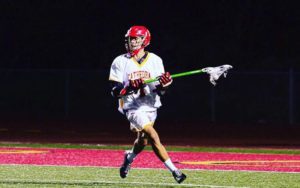
1. Please share your recruiting story and status.
The process was very long but was very exciting at the same time. Towards the beginning of high school I was so set on playing at a division 1 school, until I realized all of the advantages of attending a smaller school at the division 3 level. On August 25, I verbally committed to Elmhurst College.
2. What school are you going to, and why did you choose them?
I committed to Elmhurst College because I felt like it was the best all-around fit for me. I fell in love with the city of Chicago, the opportunity to be a part of the honors program and be involved in the biology program to prepare me for medical school, and the environment that coach Morrell and his staff are creating at the school was very intriguing.
3. How did SportsForce help in the process?
SportsForce definitely played a huge role in my recruiting process. It opened up opportunities with the schools that ended up being in my top 10 and allowed me to get in touch with coaches in a simple way. Also, the player profile that SportsForce sets up on their website for you helps a lot and makes it easy for the coaches to see everything they need from you in one setting.
4. What advice would you give to other players and parents with the recruiting process?
I would definitely recommend starting early and not being afraid of reaching out to college coaches. With kids as young as 8th grade committing, getting a highlight video out to coaches as early as possible is definitely a good start. Also, getting in contact with coaches of schools that you think you want to pursue is key; if they don’t know you, you have no chance of playing at that school.
5. How excited are you for your future in college?
I am extremely excited to be attending Elmhurst College next year. Living in Chicago is going to be a lot of fun and getting a great education at a high-achieving school and playing lacrosse for a program that is headed in the right direction are just a few of the exciting factors.
6. How much money do you anticipate your family saving in college expenses because of you being recruited?
I anticipate my family saving a total of around $80,000 over the course of my 4 years in college.
7. Would you recommend SportsForce to any other student-athletes? Why?
I would recommend SportsForce to any athlete looking to play a college sport because of all of the help their service provides. SportsForce really makes sure you end up at the best-fitting school and provides you the tools and resources you need to easily make contact with the coaches of your choosing.
Over the last five years, SportsForce has helped over 1,000 student-athletes and families successfully navigate the college recruiting and athletic scholarship process while saving families on average $50,000 in college expenses.
2016-17 NCAA Division I Recruiting Calendar (with explanations)
With this year’s summer club seasons complete and fall tryouts proceeding through late August and September, we thought this was the perfect time to take a look at NCAA DI recruiting schedules for college lacrosse and see where they fit in our fall recruiting plan. Additionally, we’ve provided the NCAA definitions of each recruiting period on the calendar. You can find all the information below, straight from the NCAA, at the following links:
NCAA Division I Men’s Lacrosse Recruiting Calendar:
https://www.ncaa.org/sites/default/files/June2016_DIMensLacrosseCalendar_20160613.pdf
NCAA Recruiting Calendar FAQs:
http://www.ncaa.org/student-athletes/resources/recruiting-calendars?division=d1
Contact Periods
A contact period is a period of time when it is permissible for authorized athletics department staff members to make in-person, off-campus recruiting contacts and evaluations.
During a contact period a college coach may have face-to-face contact with college-bound student-athletes or their parents, watch student-athletes compete and visit their high schools, and write or telephone student-athletes or their parents.
Contact Defined: A contact is any face-to-face encounter between a prospective student-athlete or the prospective student-athlete’s relatives, guardian(s) or individual of a comparable relationship and an institutional athletics department staff member or athletics representative during which any dialogue occurs in excess of an exchange of a greeting. Any such face-to-face encounter that is prearranged (e.g., positions himself/herself in a location where contact is possible) or that takes place on the grounds of the prospective student-athlete’s educational institution or at the site of organized competition or practice involving the prospective student-athlete or the prospective student-athlete’s high school, preparatory school, two-year college or all-star team shall be considered a contact, regardless of the conversation that occurs. Any communication (e.g., face-to-face, telephone call or electronic transmission) with a prospective student-athlete at the site of organized competition involving the prospective student-athlete by athletics personnel who are attending the competition or who are aware of the competition also shall be considered a contact.
Evaluation Periods
An evaluation period is a period of time when it is permissible for authorized athletics department staff members to be involved in off-campus activities designed to assess the academic qualifications and playing ability of prospective student-athletes. No in-person, off-campus recruiting contacts shall be made with the prospective student-athlete during an evaluation period.
During an evaluation period a college coach may watch college-bound student-athletes compete, visit their high schools, and write or telephone student-athletes or their parents. However, a college coach may not have face-to-face contact with college-bound student-athletes or their parents off the college’s campus during an evaluation period.
Evaluation Defined: An evaluation is any off-campus activity designed to assess the academic qualifications or athletics ability of a prospective student-athlete, including any visit to a prospective student-athlete’s educational institution (during which no contact occurs) or the observation of a prospective student-athlete participating in any practice or competition at any site.
Quiet Periods
A quiet period is a period of time when it is permissible to make in-person recruiting contacts only on the institution’s campus. No in-person, off-campus recruiting contacts or evaluations may be made during the quiet period.
During a quiet period, a college coach may only have face-to-face contact with college-bound student-athletes or their parents on the college’s campus. A coach may not watch student-athletes compete (unless a competition occurs on the college’s campus) or visit their high schools. Coaches may write or telephone college-bound student-athletes or their parents during this time.
Dead Periods
A dead period is a period of time when it is not permissible to make in-person recruiting contacts or evaluations on or off the institution’s campus or to permit official or unofficial visits by prospective student-athletes to the institution’s campus. It remains permissible, however, for an institutional staff member to write or telephone a prospective student-athlete during a dead period.
IMPORTANT TO NOTE
Institutional staff members may receive telephone calls placed by a prospective student-athlete at the prospective student-athlete’s own expense at any time, including before July 1 following the prospective student-athlete’s junior year in high school.
So please use this information to plan your fall/winter recruiting cycle. Form your plan early, then just play hard, have fun, and good luck!
Do you have an “off-season”?
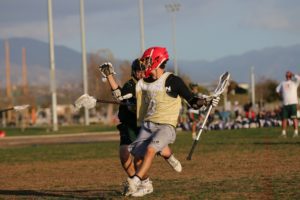
In the last decade or so, a number of camps, showcases, tournaments and club teams have grown exponentially. Year-round lacrosse has become the norm, even in colder weather states. This includes play for both high school programs and club teams. With this trend of the ever-expanding season, there has been an increase in a number of players either getting injured or burning out at a young age. In this regard, the volume and accessibility of events, teams, and programs aimed at aiding with development and providing exposure to college coaches has been both a blessing and a curse.
With this newfound accessibility and today’s technology, more players are getting opportunities to be recruited by schools they would have previously never considered, even 10 years ago. Players can be recruited on a national level more easily, which gives student-athletes a better chance to find their best-fit college program. Players are getting more informed on the recruiting process and exposed to the different levels and divisions of college lacrosse. In general, it is easier to find a good athletic/academic/financial match than in previous years.
Our “regular season” is typically where we want to be at our best, as we have a daily practice and can play a brand of lacrosse more like the college game. The challenge that we all face, as both players and coaches, revolves around the schedule. The LEAST convenient and LEAST realistic time for colleges to see you play is during your high school season. Coaches may occasionally be able to make it to a local game or to a game while on a road trip, but they are consumed with their own seasons, which puts a live evaluation on the back burner. So naturally, coaches are most actively recruiting and evaluating from late May-January. As it happens, the bulk of quality recruiting showcases and tournaments are scheduled during that period as well.
The most elite professional athletes in the world have a schedule that includes stretches of time devoted to rest (not complete inactivity, but a break from the repetitive motions required to compete). It’s literally scheduled into their training plans by most professional sports teams’ training staffs. So why do so many high school lacrosse players think it’s ok to have a longer season and less rest than professionals? High school athletes are not done growing and developing. They have likely not prepared themselves physically to handle the strain they are putting on their bodies. They haven’t given their bodies any sufficient, extended period of time to heal, recover, and grow.
It’s a good idea that physical and mental rest be factored into every family’s plan for their growing student-athlete. Whether it be private lessons, camps, showcases, tournaments, club teams, training programs, or other specialty events, sometimes the correct answer is no. Families are dedicating increasing amounts of time and money every year hoping to find that golden ticket at the next event that gives their son a lacrosse scholarship. It is not uncommon to see high school players who never take a break from playing tournaments, high intensity camps, or other showcases for longer than a few weeks.
So what is the solution? These events/teams are not going away anytime soon, and likely they will only continue to increase in number and frequency. The burden of this responsibility really lies on players and their families to make smart, responsible decisions. Each player’s calendar will likely be unique to his situation.
Here are some tips to help set you up for success and health…
- Plan your calendar in advance for the entire year. Start with the active playing seasons (high school/club) and carefully select additional events and training as they fit in your schedule.
- Do not enter an event where you are expected to perform at max speed/intensity without preparing physically. Getting ready to play requires at least a week or two of cardio, agility, and flexibility workouts.
- Plan a few periods of consecutive (2-3 minimum) weeks of rest throughout the year.
- Use your down time for strength/conditioning training, stick skills, and light lacrosse activity. Get back to fundamentals and lower intensity drills aimed to maintain and develop skills/mechanics.
- It’s ok to say no. It is flattering to be invited or chosen to play or participate in many events. Sometimes, however, it is not necessary. Plan in advance and try to avoid spur of the moment decisions on events you are not ready for physically, mentally, or financially.
- PLAY MULTIPLE SPORTS! It creates a natural off-season. Even if it is recreational or you will never play in college, it gives your mind and body a break. In most cases, the skills and coordination learned in other sports translates to you being a better athlete and lacrosse player.
Jacob Benson Feature Athlete Interview – Committed to University of La Verne
We would like to congratulate Jacob Benson on his commitment to the University of La Verne! Here are Jacob’s recruiting story and interview after his commitment. Good luck as a Leopard!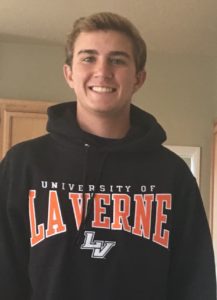
Jack Pharies Feature Athlete Interview – Committed to Centre College
We would like to congratulate Jack Pharies on his commitment to Centre College! Here are Jack’s recruiting story and interview after his commitment. Good luck as a Colonel!
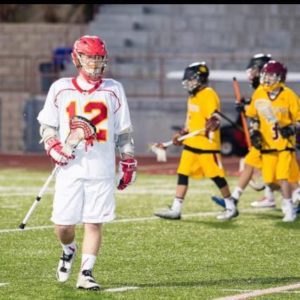
1. Please share your recruiting story and status
I was actively recruited by over 20 colleges to play lacrosse. I narrowed down my choices to 3 colleges by the beginning of the summer before my senior year, and I committed to a college in July before my senior year.
2. What school are you going to, and why did you choose them?
I chose Centre College, which competes at the NCAA Division III level in the Southern Athletic Association. Centre is a national liberal arts college located in Danville, Kentucky. It was founded in 1819, has a national reputation for the quality of its academics, and is the number 1 school in the nation of any size for its travel abroad programs. I realized from the beginning that I would not make a living playing lacrosse, so my main focus has been choosing a college I would want to attend even if I did not play lacrosse. I have been interested in Centre from the beginning because of its size, the relationship between the faculty and students, and its travel abroad opportunities. Centre is among many schools that do not actively recruit in California. I contacted Centre through Sportsforce, and luckily the coach liked my video and asked me to campus. I already had offers from other colleges by the time I visited Centre, but I was just blown away by Coach Sharbaugh and Centre. Everything seemed to fit perfectly with what I wanted. The academics are great, the campus is beautiful, and the lacrosse coach is terrific and has a clear vision for the program and my role in realizing that vision.
4. How did SportsForce help in the process?
Sportsforce played a critical role in my recruiting journey. The best way to put it is that Sportsforce allowed me to control the recruiting process rather than the recruiting process controlling me. Without Sportsforce, I would have to rely on being seen at a showcase as my primary recruiting tool. While showcases are important, and I was recruited by coaches who saw me at showcases, it limits the universe of potential colleges to those that attend particular showcases. Sportsforce allowed me to introduce myself to the colleges I wanted to attend, not just the ones that happened to be at this weekend’s showcase. I could target a school, use Sportsforce as a way to get noticed by the coach, and then drive the recruiting process from there. It also allowed me to get ahead of the recruiting cycle so that, at each school that gave me an offer, I was one of the first offers they gave to players in my class. This proved to be an unexpected benefit because nothing makes a coach want a player more than knowing that a competing school wants that same player. This gave me a big advantage in recruiting because it put me in the driver’s seat. Not only did Sportsforce give me the tools to control my own destiny, it guided me every step of the way. From producing my initial video to the first e-mail campaign, to campus visits, and ultimately to making my commitment, Coach Hadlock and Sportsforce have advised me, supported me, and encouraged me.
4. What advice would you give to other players and parents with the recruiting process?
First, recruiting begins with grades. One of the first question every college coach asked me was my GPA and test scores. To keep your options open, you need to keep the grades up and do well on standardized tests.
Second, choose a college that you would want to attend even if you couldn’t play lacrosse. After all, every player is only one injury away from becoming a spectator.
Third, get to know the coach and the lacrosse program well and make sure you share the same goals. Find out how the coach recruits – is he selective in who he recruits or does he recruit huge classes and let the Freshman fight it out when fall ball starts. What is the lacrosse team’s reputation on campus – both among other athletes and the student body at large? Do the coach and the athletic department support your academic goals? Does the team have an academic adviser who travels with the team? Will the coach support your academic goals even if they require an absence from some training (such as for study abroad if that’s important to you).
Fourth, do an overnight visit. It is important to meet the team, see what it’s really like on campus, and understand the issues the current players face.
5. How excited are you on your future in college?
It is the perfect school and team for me. The academic environment, with small class sizes and an exclusive focus on undergraduate education, will challenge me and allow me to reach my goal of going to law school. The lacrosse team is always competitive in its conference and I’m going to travel throughout the South during conference play. I can’t wait to experience a different part of the country. In short, I am very excited. Go, Colonels!!
6. How much money do you anticipate your family saving in college expenses?
My school is NCAA Division III, so there are no athletic scholarships. However, I have been told that I will receive nearly $20,000 per year in academic scholarships.
7. Would you recommend SportsForce to any other student-athletes? Why?
I strongly recommend Sportsforce. It provides the tools to allow the player to control the recruiting process. Most players and parents go into the recruiting process with no idea of what it entails or what to expect. All of the coaches, however, do this every year and know exactly what they are doing. This necessarily puts players at a disadvantage. Sportsforce helps to not only level the playing field with their knowledge and guidance, but they help put the player in control of that process by giving the player the tools to target schools, get noticed by the coaches, and to get ahead of the recruiting cycle.
Over the last five years, SportsForce has helped over 1,000 student-athletes and families successfully navigate the college recruiting and athletic scholarship process while saving families on average $50,000 in college expenses.
How good is your highlight reel?
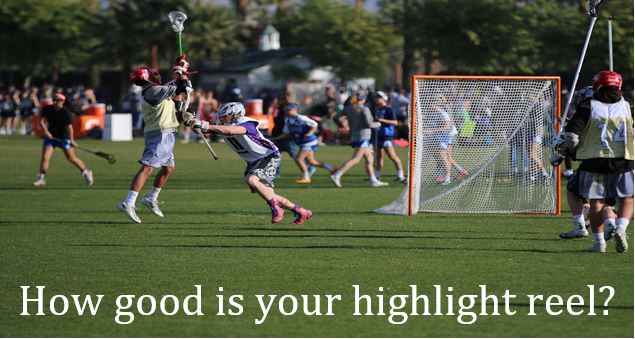
…and just what are you showing to college coaches?
Now that many of the club teams and tournaments are winding down until October, it’s important to capitalize on your summer experience. While many parents elect to purchase professional videos from the various events, the quality of the video is only one component of what makes an effective and attention-grabbing highlight reel.
In this installment of our College Game Plan Education series, we’ll provide some basic tips for creating and editing your game film to make the best impression on potential college lacrosse recruiters.
What you want to show
The goal with any highlight reel is to give college coaches an idea of how you can play the game and the special talents you believe set you apart. Whether it’s 1-on-1 defense, shooting, open-field speed, or FOGO skills, you want the reel to have a definite theme. Don’t get us wrong, you absolutely need to show more than one skill set, but you want your highlights to be a representation of your strongest attributes, allowing coaches to evaluate how you play and where you might fit in their program.
What you don’t want to show
Lacrosse is a flow sport, meaning that the action never really stops. Unlike football or baseball, where a “play” has a beginning and an end, lacrosse can thrust a player from offense to a loose ball to defense in a very short time. This makes editing clips very important. Factors like the quality of your competition, your demonstrated lacrosse IQ, and how you interact with your team may not jump out to a young player, but college coaches can take a lot from the fringes of your video. Typical examples of no-nos would be dodging through several defenders to score a goal despite open teammates, taunting the opposition, performing a solo celebration that is only about you, or passing up a good shot to go for a BTB or other “fancy” shot. If you drop the ball three times on your way to the goal or miss a pass before picking it up to score, the clip should only include the ground ball and the shot. And just as an FYI, coaches usually aren’t terribly impressed that you are good enough to try an advanced move in a game…if it didn’t work, don’t include it.
Sequencing your clips
The first 45 seconds of your video will likely dictate whether a coach watches the whole thing, so don’t bury your best clips or try to crescendo at the end. After you show your personal information, take the three most impressive examples of how you play and lead with them.
After these initial clips, start to mix in the other aspects of your game to show you have more than one dimension. Continue to pepper in the clips that support your general video theme, whether you’re presenting yourself as a scorer, feeder, ground ball specialist, or defender. Again, the best of these clips should be toward the front as well. For the remainder of the 3-4 minute highlight reel, simply mix in the various clips you have, but with the understanding that sometimes less is more, so don’t add extra clips to get to a certain video length if they don’t truly show your skill level or what you can do.
Guidelines for your highlight reel:
- Start with your name, class, school name, and club team (include GPA if 3.5+)
- The first few clips are your best…the “wow” clips that grab attention
- Scour your clips and edit to ensure you’re not showing anything undesirable
- Don’t exceed 3-4 minutes of clips
- Include your contact info and your coaches’ contact info
Most college coaches will request a video before they take the time to talk to you, so it’s very important to make sure you’re truly aware of what you’re presenting. Ask your coach to look at it and provide feedback before sending it out to college programs, make any suggested edits, and good luck!!
Delanie Sheehan Feature Athlete Interview – Committed to UCLA
We would like to congratulate Delanie Sheehan on her commitment to UCLA! Here are Delanie’s recruiting story and interview after her commitment. Good luck as a Bruin!
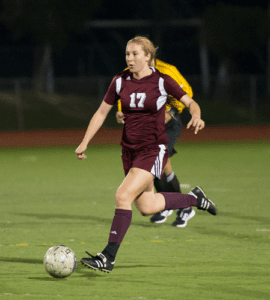
1. Share your recruiting story and status
The process of getting recruited was really stressful and overwhelming for me. I felt lost, especially at first when I didn’t have professionals helping me. However, into my junior year, my options started opening up and I became more excited than stressed! It was fun to learn about all the different programs and hear their philosophies and learn about the schools. I ended up signing May of my junior year.
2. What school are you going to, and why did you choose them?
I will be attending UCLA in the fall of 2017. UCLA has been my dream school for as long as I can remember, so when they contacted me back it was like a dream come true and I was determined to play there, no matter what! I wasn’t going to let this opportunity slip away from me. Their amazing soccer program, along with the academics, has always been what I dreamed of when considering what college I wanted to attend. I want to be pushed in every aspect of my life and this is the perfect fit for it. I feel UCLA will not only help me academically and athletically, but it will help me grow as a person as well. The school’s standards and beliefs are inspiring to me.
3. How did SportsForce help in the process?
SportsForce was a huge help in this process. Schools get hundreds of emails every week and sometimes don’t even open them. SportsForce helps you stand out from the rest and give you a professional look. It allowed me to focus more on choosing a school, rather than getting in contact with the school. I would tell them which schools I was interested in and they would find a way to make it happen. I wouldn’t have had the opportunities I had without it.
4. What advice would you give to other players and parents with the recruiting process?
I would say it’s never too early to start. I started really focusing on the recruiting process at the beginning of my junior year, and even this was late. Top programs are ahead of the game and you must be aware of that. Also, highlight videos are important. I caught UCLA’s attention with my highlight video and then they came out to watch me play. When contacting coaches you need something to separate yourself from the rest and a video usually does the trick. My last piece of advice would be not to be scared to contact the coaches. I struggled with this and was always nervous to call, but all the coaches I met were awesome and always willing to give me the time of day.
5. How excited are you for your future in college?
I am so excited to attend UCLA; it feels unreal to me sometimes! I’m proud to say I accomplished my goal of attending my dream school and can’t wait to be repping the Bruins on and off the field!!
6. How much money do you anticipate your family saving in college expenses because of you being recruited?
I anticipate my family saving about half the cost of college because of me being recruited.
7. Would you recommend SportsForce to any other student-athletes?
Yes, I would recommend SportsForce to other student-athletes because for most families the recruiting process is new and confusing. It is important to have professionals who know what they are doing on your side. You may miss out on opportunities that you could’ve had. SportsForce gives you an organized plan of action and is willing to help you reach your goals.
Over the last five years, SportsForce has helped over 1,000 student-athletes and families successfully navigate the college recruiting and athletic scholarship process while saving families on average $50,000 in college expenses.
James Percival Feature Athlete Interview – Committed to Hill College
We would like to congratulate James Percival on his commitment to Hill College! Here are James’ recruiting story and interview after his commitment. Good luck as a Rebel!
Payoff at Division III is Greater Than You Think

In our work with families, it’s common for student-athletes to be drawn to the NCAA Division I experience. It makes sense. Whether they are true DI level student-athletes or not, that’s typically the only form of collegiate competition they see or hear about on TV or in the media.
NCAA DI and DII sports programs offer the most competitive landscape for securing roster spots and athletic scholarships. Only about 2 percent of players are offered DI or DII scholarships, and many of these are relatively small amounts. It is extremely rare for DI or DII student-athletes to secure full ride scholarships.
Due to this intense competition, it’s normal for many players at these collegiate levels to ultimately land at DIII schools. According to the NCAA, Division III is the largest division in terms of a number of schools and number of participants and is comprised of more than 190,000 student-athletes and represents 450 colleges and universities throughout the country. Division III is also the only division that does not award athletic scholarships; however, more than 75 percent of Division III student-athletes receive financial aid or have earned a merit scholarship for academic talent and accomplishment.
Although there are many, the three most often repeated benefits our families mention when attending and competing for DIII programs is that it allows the student-athlete:
- To maintain a well-rounded collegiate experience. Although the sports programs are very competitive and place a strong emphasis on winning, there is an opportunity for the student-athlete to participate in extra-curricular activities like semesters studying abroad, student government and Greek life.
- To attend strong academic institutions with advanced and well-positioned internships for future careers.
- To secure significant merit-based scholarships for academics or other special talents they may possess.
Many Division III institutions have extraordinary supplies of money to attract high-performing student-athletes and can offer exceptional value to families. Listed below is a recent email from a DIII soccer family to share as an example:
“Actually, we did quite well with her grants, scholarships, and loans…
She received the following package:
GRANTS/ SCHOLARSHIPS (four-year grants, spread equally over the four years):
- The University Scholar Award – $72,000
- Board of Directors Grant – $33,716
- Residency Grant – $8000
Total Grants: $113,716
PRE-APPROVED GUARANTEED UNIVERSITY STUDENT LOANS:
- $14,000 subsidized (no interest)
- $8000 unsubsidized (very low interest)
Total Loans: $22,000 (to be repaid after graduation and full-time employment)
WORK STUDY:
$6000 – guaranteed position in the federal work study program all four years
So they delivered a total of $141,716, which represents approximately 75% of her entire undergraduate education ($191,064), including tuition, books, room & board.
Another great bonus, based on her major (International Business), is that they will send her abroad her sophomore year… at their cost.
Finally, they guarantee graduation in four years.
As it turns, she was their top female soccer recruit, but we did not know that until after she committed (her new teammates let the cat out of the bag).
Note: She improved her GPA and her SAT scores during the application process, and she promptly notified the University, and they increased her financial package accordingly, which I also liked.
In fact, there is now one other scholarship that she is academically eligible to apply for, but she missed the February deadline (because she hadn’t even visited the school yet then, and they really weren’t even on her radar), so they sent her a letter, and they want her to apply next year (the Provost Scholarship), and if she gets it, she will get another $6000 in scholarship money ($2k per year for the last three years), and they will adjust my payments.
She is very excited for the opportunity, and I hope that it all works out for her. I will keep in touch to let you all know how she does.
Thank you for your assistance.”
Whether your son or daughter has the desire to compete in their sport at NCAA Division I, II or III college levels, Division III institutions may present significant academic and athletic opportunities that you did not know existed.
For a personal college recruiting evaluation and honest estimate of your potential to compete at the next level, contact us at:
Phone: 1.888.9787084
Email: scouting@sportsforceonline.com




